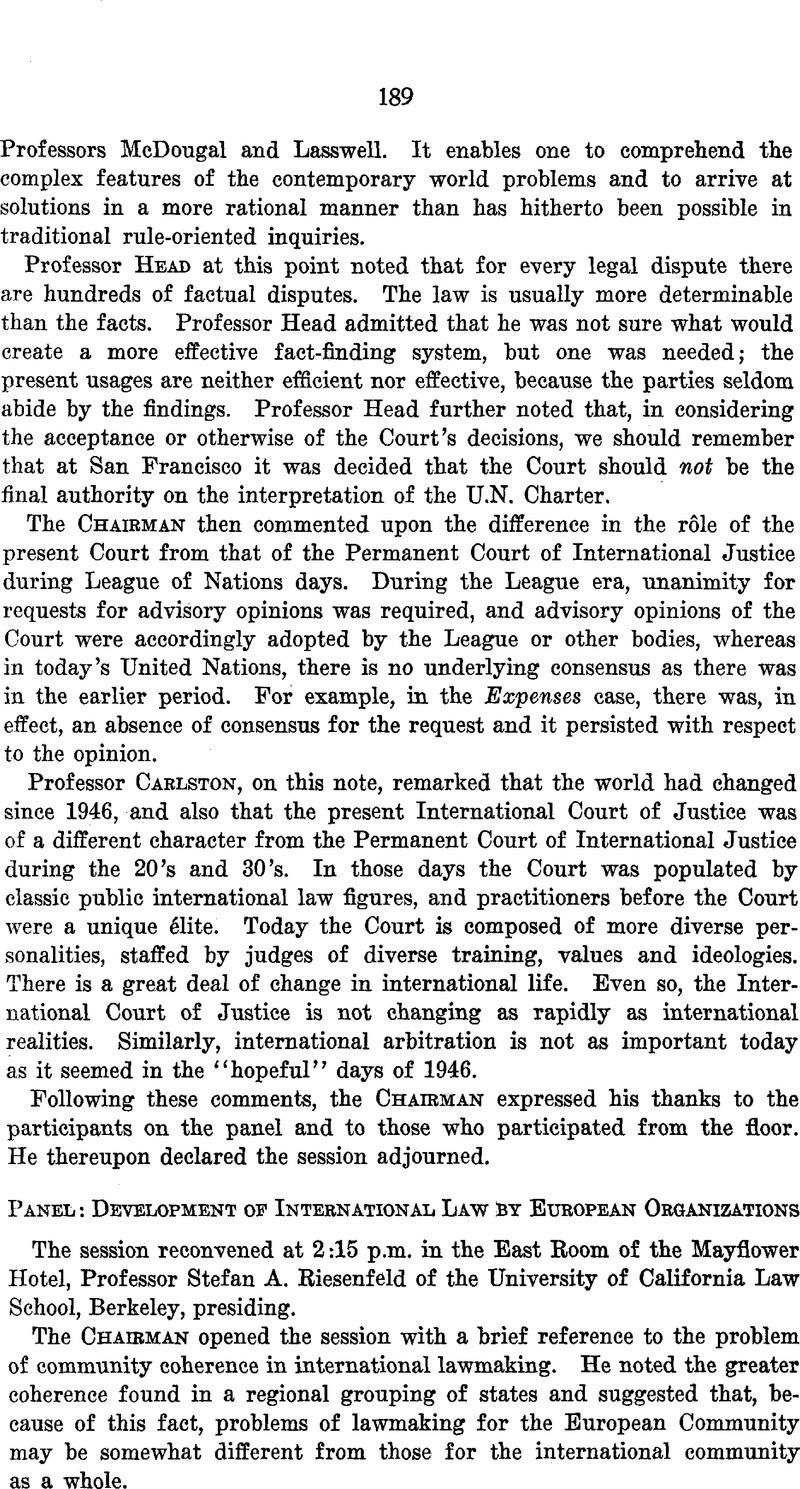No CrossRef data available.
Article contents
The Court of Justice of the European Communities and the Development of International Law1
Published online by Cambridge University Press: 27 February 2017
Abstract

- Type
- Fourth Session
- Information
- Proceedings of the American Society of International Law at its annual meeting (1921-1969) , Volume 59 , 1965 , pp. 189 - 195
- Copyright
- Copyright © American Society of International Law 1965
Footnotes
For comment and counsel, I am grateful to Godfried van Benthem van den Bergh of the University of Leiden and to Professors Henry Steiner and Stanley Hoffmann of Harvard University.
References
2 I prefer to leave aside disputes between member governments which can be brought directly to the European Court, like those covered by Arts. 172 and 182 of the Treaty of the European Economic Community. With respect to such litigation, the court does perhaps have international law competence per se. However, at present it would be impossible to advance beyond speculation, since this kind of litigation has not yet materialized.
3 See Philip C. Jessup, Transnational Law (New Haven: Yale University Press, 1956). Somewhat similar approaches are to be found in K. S. Carlston, Law and Organization in World Society (Urbana: University of Illinois Press, 1962), and in W. Friedmann, Law in a Changing Society (Berkeley: University of California Press, 1959).
4 See Maurice Lagrange, “The Eole of the Court of Justice of the European Communities as Seen through Its Case Law,” 26 Law and Contemporary Problems 407-408 (1961).
5 Art. 173, par. 2: “Any natural or legal person may, under the same conditions, appeal against a decision addressed to him or against a decision which, although in the form of a regulation or a decision addressed to another person, is of direct and specific concern to him.” (Italics supplied.)
6 See, for example, 25/62, Plaumann & Co. v. Commission (EEC), 9 Eecueil 197 (1963).
7 See Eric Stein, “Toward Supremacy of Treaty-Constitution by Judicial Fiat: on the Margin of the Costa Case,” 63 Michigan Law Bev. 491-518 (1965). See also Stefan A. Eiesenfeld and Bichard M. Buxbaum, “N. V. Algemene Transport—En Expeditie Onderneming Van Gend & Loos c. Administration Fiscale Neerlandaise: A Pioneering Decision of the Court of Justice of the European Communities,” 58 A.J.I.L. 152-159 (1964).
8 13/57, Wirtschaftsvereinigung Eisen- und Stahlindustrie et al. v. Haute Autorit§, 4 Eeeueil 261, 290-291 (1958).
9 See Nottebohm Case (Liechtenstein v. Guatemala), [1955] I.C.J. Eep. 4; Anglo- Iranian Oil Company Case (United Kingdom v. Iran) [1952] ibid. 93; and Interhandel Case (Switzerland v. United States), [1959] ibid. 6.
10 I Oppenheim, International Law 953 (8th ed. London: Longmans, Green, 1955).
11 See, for example, Certain Expenses of the United Nations (Advisory Opinion), [1962] I.C.J. Eep. 151; Status of South-West Africa (Advisory Opinion), [1950] ibid. 129; and Separations for Injuries Suffered in the Service of the United Nations (Advisory Opinion), [1949] ibid. 174. See also Inis L. Claude, Jr., Swords into Plowshares 149-159 (3rd ed. New York: Eandom House, 1964).
12 See Gerhard von Glahn, Law Among Nations 431 (New York: Macmillan, 1965): “Still another approach to treaty interpretation—all others having failed—is to relate one's inquiry to the function intended to be served by the treaty… . Numerous commentators concur in the belief that the functional approach to treaty interpretation was developed primarily by the Permanent Court of International Justice and constitutes today one of the most promising methods of treaty analysis.“
13 Certainly some tension is generated simply by the European Court's rejection of international law. It is altogether natural that those who identify with the tradition are miffed by what seems to them a rather cavalier rejection of its experience and wisdom.
14 Politically there is a similar pattern. Should not the Community be able to digest new members more effectively after its own internal consolidation? If so, whatever may be the drawbacks of Gaullist methods, it may have been just as well that the Community was not exposed to the potentially disruptive influence of a luke-warm Great Britain, particularly since Prime Minister MaeMillan had chosen to make membership a partisan issue.
15 See, for example, 34/62 Gouvernement de la Kfipublique f6d6rale d'Allemagne v. Commission (EEC), 9 Eecueil 269 (1963).
16 10/61 Commission (EEC) v. Gouvernement de la Republique italienne, 8 Eecueil 22-23 and 37-38, respectively (1962).
17 Ibid. 37. (Translation taken from Commerce Clearing House, 2 Common Market Eeporter 713.)
18 6/64 Costa v. E.N.E.L., 10 Recueil 1141 (1964). (Italics supplied.)
19 See H. L. A. Hart, The Concept of Law 126 (Oxford University Press, 1961). Moreover, when applying standards of success to Community programs, the judges have usually been content to impose standards of procedural purity while deferring to the economic assessment made by the executive.




